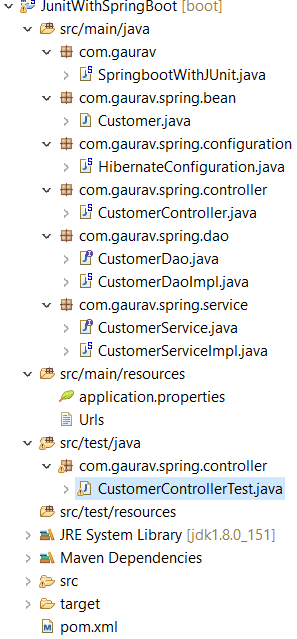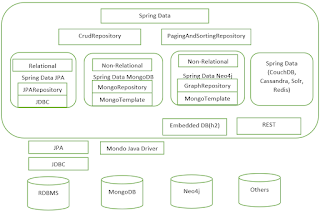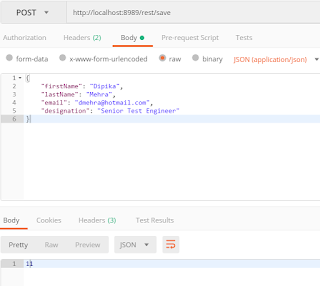Junit for REST Web Service using Spring Boot
Dependency needed for this project:
- Web
- MySQL
- JPA
- Test
- Spring-boot-maven-plugin
@WebMvcTest which is used for
testing Spring MVC application. For this test, we will focus on testing the
Controller class.
@RunWith(SpringRunner.class)
: SpringRunner is a form of SpringJUnit4ClassRunner
which extends BlockJUnit4ClassRunner and provides the functionality to launch a
Spring Test Context Framework.
@Autowired private
MockMvc mockMvc : MockMvc is main entrance for server-side Spring MVC test
support. It helps us to execute requests against the test context.
@MockBean
private CustomerService customerService:
MockBean is used to add mocks to a Spring ApplicationContext. A mock of
customerService is created and auto-wired into the CustomerController.
JSONAssert.assertEquals(): We can use org.skyscreamer.jsonassert.JSONAssert which allows us to do partial asserts against a String of JSON type. We can pass strict as false since we do not want to check for all fields in the response.
1. pom.xml
<project xmlns="http://maven.apache.org/POM/4.0.0" xmlns:xsi="http://www.w3.org/2001/XMLSchema-instance"
xsi:schemaLocation="http://maven.apache.org/POM/4.0.0 http://maven.apache.org/xsd/maven-4.0.0.xsd">
<modelVersion>4.0.0</modelVersion>
<groupId>com.gaurav</groupId>
<artifactId>JunitWithSpringBoot</artifactId>
<version>0.0.1-SNAPSHOT</version>
<packaging>war</packaging>
<properties>
<java.version>1.8</java.version>
</properties>
<parent>
<groupId>org.springframework.boot</groupId>
<artifactId>spring-boot-starter-parent</artifactId>
<version>1.5.1.RELEASE</version>
</parent>
<dependencies>
<dependency>
<groupId>org.springframework.boot</groupId>
<artifactId>spring-boot-starter-web</artifactId>
</dependency>
<dependency>
<groupId>mysql</groupId>
<artifactId>mysql-connector-java</artifactId>
</dependency>
<dependency>
<groupId>org.springframework.boot</groupId>
<artifactId>spring-boot-starter-data-jpa</artifactId>
</dependency>
<dependency>
<groupId>org.springframework.boot</groupId>
<artifactId>spring-boot-starter-test</artifactId>
<scope>test</scope>
</dependency>
</dependencies>
<build>
<finalName>JunitWithSpringBoot</finalName>
<plugins>
<plugin>
<groupId>org.springframework.boot</groupId>
<artifactId>spring-boot-maven-plugin</artifactId>
</plugin>
</plugins>
</build>
</project>
2. Customer.java
package com.gaurav.spring.bean;
import javax.persistence.Column;
import javax.persistence.Entity;
import javax.persistence.GeneratedValue;
import javax.persistence.GenerationType;
import javax.persistence.Id;
import javax.persistence.Table;
@Entity
@Table(name = "Customer")
public class Customer {
public Customer(){
}
public Customer(int id, String firstName, String lastName, String gender, int age) {
super();
this.id = id;
this.firstName = firstName;
this.lastName = lastName;
this.gender = gender;
this.age = age;
}
@Id
@GeneratedValue(strategy = GenerationType.AUTO)
private int id;
@Column(name = "first_name")
private String firstName;
@Column(name = "last_name")
private String lastName;
@Column(name = "gender")
private String gender;
@Column(name = "age")
private int age;
public int getId() {
return id;
}
public void setId(int id) {
this.id = id;
}
public String getFirstName() {
return firstName;
}
public void setFirstName(String firstName) {
this.firstName = firstName;
}
public String getLastName() {
return lastName;
}
public void setLastName(String lastName) {
this.lastName = lastName;
}
public String getGender() {
return gender;
}
public void setGender(String gender) {
this.gender = gender;
}
public int getAge() {
return age;
}
public void setAge(int age) {
this.age = age;
}
@Override
public int hashCode() {
final int prime = 31;
int result = 1;
result = prime * result + id;
return result;
}
@Override
public boolean equals(Object obj) {
if (this == obj)
return true;
if (obj == null)
return false;
if (getClass() != obj.getClass())
return false;
Customer other = (Customer) obj;
if (id != other.id)
return false;
return true;
}
}
3. CustomerDao.java
package com.gaurav.spring.dao;
import java.util.List;
import com.gaurav.spring.bean.Customer;
public interface CustomerDao {
public Integer addCustomer(Customer customer);
public List<Customer> getCustomer();
public Customer findById(int id);
public Customer update(Customer customer, int id);
public boolean delete(int id);
}
4. CustomerDaoImpl.java
package com.gaurav.spring.dao;
import java.util.List;
import org.hibernate.Session;
import org.hibernate.SessionFactory;
import org.springframework.beans.factory.annotation.Autowired;
import org.springframework.stereotype.Repository;
import com.gaurav.spring.bean.Customer;
@Repository
public class CustomerDaoImpl implements CustomerDao {
@Autowired
private SessionFactory sessionFactory;
public Integer addCustomer(Customer customer) {
Session session = sessionFactory.getCurrentSession();
Integer id = (Integer)session.save(customer);
System.out.println("Generated Identifier is:"+id);
System.out.println("after customer : customer id's = "+customer.getId());
return id;
}
@SuppressWarnings("unchecked")
public List<Customer> getCustomer() {
Session session = sessionFactory.getCurrentSession();
List<Customer> list = session.createCriteria(Customer.class).list();
return list;
}
public Customer findById(int id) {
Session session = sessionFactory.getCurrentSession();
Customer customer = (Customer) session.get(Customer.class, id);
return customer;
}
public Customer update(Customer customerObj, int id) {
Session session = sessionFactory.getCurrentSession();
Customer customer = (Customer) session.get(Customer.class, id);
customer.setFirstName(customerObj.getFirstName());
customer.setLastName(customerObj.getLastName());
customer.setGender(customerObj.getGender());
customer.setAge(customerObj.getAge());
session.update(customer);
return customer;
}
public boolean delete(int id) {
boolean isExistsAndDeleted = false;
Session session = sessionFactory.getCurrentSession();
Customer customer = findById(id);
if (customer != null) {
session.delete(customer);
isExistsAndDeleted = true;
}
return isExistsAndDeleted;
}
}
5. CustomerService.java
package com.gaurav.spring.service;
import java.util.List;
import com.gaurav.spring.bean.Customer;
public interface CustomerService {
public Integer createCustomer(Customer customer);
public List<Customer> getCustomer();
public Customer findById(int id);
public Customer update(Customer customer, int id);
public boolean deleteCustomerById(int id);
}
/** Transaction Management */
6. CustomerServiceImpl.java
package com.gaurav.spring.service;
import java.util.List;
import org.springframework.beans.factory.annotation.Autowired;
import org.springframework.stereotype.Service;
import org.springframework.transaction.annotation.Propagation;
import org.springframework.transaction.annotation.Transactional;
import com.gaurav.spring.bean.Customer;
import com.gaurav.spring.dao.CustomerDao;
@Service
@Transactional
public class CustomerServiceImpl implements CustomerService {
@Autowired
CustomerDao customerDao;
@Transactional(propagation=Propagation.SUPPORTS)
public List<Customer> getCustomer() {
return customerDao.getCustomer();
}
@Transactional(propagation=Propagation.SUPPORTS)
public Customer findById(int id) {
return customerDao.findById(id);
}
@Transactional(propagation=Propagation.REQUIRES_NEW)
public Integer createCustomer(Customer customer) {
Integer custId = customerDao.addCustomer(customer);
return custId;
}
@Transactional(propagation=Propagation.REQUIRES_NEW)
public boolean deleteCustomerById(int id) {
boolean isDeleted = customerDao.delete(id);
return isDeleted;
}
@Transactional(propagation=Propagation.REQUIRED)
public Customer update(Customer customer, int id) {
return customerDao.update(customer, id);
}
}
7. CustomerController.java
package com.gaurav.spring.controller;
import java.util.List;
import org.springframework.beans.factory.annotation.Autowired;
import org.springframework.http.HttpHeaders;
import org.springframework.http.HttpStatus;
import org.springframework.http.MediaType;
import org.springframework.http.ResponseEntity;
import org.springframework.web.bind.annotation.DeleteMapping;
import org.springframework.web.bind.annotation.GetMapping;
import org.springframework.web.bind.annotation.PathVariable;
import org.springframework.web.bind.annotation.PostMapping;
import org.springframework.web.bind.annotation.PutMapping;
import org.springframework.web.bind.annotation.RequestBody;
import org.springframework.web.bind.annotation.RequestMapping;
import org.springframework.web.bind.annotation.RestController;
import org.springframework.web.util.UriComponentsBuilder;
import com.gaurav.spring.bean.Customer;
import com.gaurav.spring.service.CustomerService;
@RestController
@RequestMapping(value = { "/customer" })
public class CustomerController {
@Autowired
CustomerService customerService;
@GetMapping(value = "/{id}", produces = MediaType.APPLICATION_JSON_VALUE)
public ResponseEntity<Customer> getCustomerById(@PathVariable("id") int id) {
System.out.println("Fetching customer with id " + id);
Customer customer = customerService.findById(id);
if (customer == null) {
return new ResponseEntity<Customer>(HttpStatus.NOT_FOUND);
}
return new ResponseEntity<Customer>(customer, HttpStatus.OK);
}
@PostMapping(value = "/create", headers = "Accept=application/json")
public ResponseEntity<Void> createCustomer(@RequestBody Customer customer, UriComponentsBuilder ucBuilder) {
customerService.createCustomer(customer);
HttpHeaders headers = new HttpHeaders();
headers.setLocation(ucBuilder.path("/customer/{id}").buildAndExpand(customer.getId()).toUri());
return new ResponseEntity<Void>(headers, HttpStatus.CREATED);
}
@GetMapping(value = "/get", headers = "Accept=application/json")
public List<Customer> getAllCustomer() {
List<Customer> customers = customerService.getCustomer();
return customers;
}
@PutMapping(value = "/update", headers = "Accept=application/json")
public ResponseEntity<String> updateCustomer(@RequestBody Customer currentCustomer) {
Customer customer = customerService.findById(currentCustomer.getId());
if (customer == null) {
return new ResponseEntity<String>(HttpStatus.NOT_FOUND);
}
customerService.update(currentCustomer, currentCustomer.getId());
return new ResponseEntity<String>(HttpStatus.OK);
}
@DeleteMapping(value = "/{id}", headers = "Accept=application/json")
public ResponseEntity<Customer> deleteCustomer(@PathVariable("id") int id) {
Customer customer = customerService.findById(id);
if (customer == null) {
return new ResponseEntity<Customer>(HttpStatus.NOT_FOUND);
}
customerService.deleteCustomerById(id);
return new ResponseEntity<Customer>(HttpStatus.NO_CONTENT);
}
}
8. HibernateConfiguration.java
package com.gaurav.spring.configuration;
import java.util.Properties;
import javax.sql.DataSource;
import org.springframework.beans.factory.annotation.Value;
import org.springframework.context.annotation.Bean;
import org.springframework.context.annotation.Configuration;
import org.springframework.jdbc.datasource.DriverManagerDataSource;
import org.springframework.orm.hibernate5.HibernateTransactionManager;
import org.springframework.orm.hibernate5.LocalSessionFactoryBean;
import org.springframework.transaction.annotation.EnableTransactionManagement;
@Configuration
@EnableTransactionManagement
public class HibernateConfiguration {
@Value("${spring.datasource.driver}")
private String DB_DRIVER;
@Value("${spring.datasource.url}")
private String DB_URL;
@Value("${spring.datasource.username}")
private String DB_USERNAME;
@Value("${spring.datasource.password}")
private String DB_PASSWORD;
@Value("${spring.jpa.hibernate.dialect}")
private String HIBERNATE_DIALECT;
@Value("${spring.jpa.show-sql}")
private String HIBERNATE_SHOW_SQL;
@Value("${spring.jpa.hibernate.ddl-auto}")
private String HIBERNATE_HBM2DDL_AUTO;
@Value("${spring.jpa.entitymanager.packagesToScan}")
private String ENTITYMANAGER_PACKAGES_TO_SCAN;
@Bean
public DataSource dataSource() {
DriverManagerDataSource dataSource = new DriverManagerDataSource();
dataSource.setDriverClassName(DB_DRIVER);
dataSource.setUrl(DB_URL);
dataSource.setUsername(DB_USERNAME);
dataSource.setPassword(DB_PASSWORD);
return dataSource;
}
@Bean
public LocalSessionFactoryBean sessionFactory() {
LocalSessionFactoryBean sessionFactory = new LocalSessionFactoryBean();
sessionFactory.setDataSource(dataSource());
sessionFactory.setPackagesToScan(ENTITYMANAGER_PACKAGES_TO_SCAN);
Properties hibernateProperties = new Properties();
hibernateProperties.put("hibernate.dialect", HIBERNATE_DIALECT);
hibernateProperties.put("hibernate.show_sql", HIBERNATE_SHOW_SQL);
hibernateProperties.put("hibernate.hbm2ddl.auto", HIBERNATE_HBM2DDL_AUTO);
sessionFactory.setHibernateProperties(hibernateProperties);
return sessionFactory;
}
@Bean
public HibernateTransactionManager transactionManager() {
HibernateTransactionManager txManager = new HibernateTransactionManager();
txManager.setSessionFactory(sessionFactory().getObject());
return txManager;
}
}
9. SpringbootWithJUnit.java
package com.gaurav;
import org.springframework.boot.SpringApplication;
import org.springframework.boot.autoconfigure.SpringBootApplication;
@SpringBootApplication
public class SpringbootWithJUnit {
public static void main(String[] args) {
SpringApplication.run(SpringbootWithJUnit.class, args);
}
}
10. application.properties
logging.level.org.springframework.web=INFO
spring.datasource.driver: com.mysql.jdbc.Driver
spring.datasource.url: jdbc:mysql://localhost:3306/experimentdemo
spring.datasource.username:root
spring.datasource.password:root
spring.jpa.hibernate.dialect:org.hibernate.dialect.MySQL5Dialect
spring.jpa.show-sql:true
spring.jpa.hibernate.ddl-auto :update
spring.jpa.entitymanager.packagesToScan:com.gaurav
11. CustomerControllerTest.java
package com.gaurav.spring.controller;
import static org.junit.Assert.assertEquals;
import java.util.Arrays;
import java.util.List;
import org.junit.Before;
import org.junit.Test;
import org.junit.runner.RunWith;
import org.mockito.InjectMocks;
import org.mockito.Mockito;
import org.mockito.MockitoAnnotations;
import org.skyscreamer.jsonassert.JSONAssert;
import org.springframework.beans.factory.annotation.Autowired;
import org.springframework.boot.test.autoconfigure.web.servlet.WebMvcTest;
import org.springframework.boot.test.mock.mockito.MockBean;
import org.springframework.http.HttpHeaders;
import org.springframework.http.HttpStatus;
import org.springframework.http.MediaType;
import org.springframework.mock.web.MockHttpServletResponse;
import org.springframework.test.context.junit4.SpringRunner;
import org.springframework.test.web.servlet.MockMvc;
import org.springframework.test.web.servlet.MvcResult;
import org.springframework.test.web.servlet.RequestBuilder;
import org.springframework.test.web.servlet.request.MockMvcRequestBuilders;
import org.springframework.test.web.servlet.setup.MockMvcBuilders;
import com.gaurav.spring.bean.Customer;
import com.gaurav.spring.service.CustomerService;
@RunWith(SpringRunner.class)
@WebMvcTest(value = CustomerController.class)
public class CustomerControllerTest {
@Autowired
private MockMvc mockMvc;
@MockBean
CustomerService customerService;
Customer mockCustomer = new Customer(3, "Kumar","Gaurav", "Male", 34);
List<Customer> mockCustomerList = Arrays.asList(new Customer(3, "Kumar","Gaurav", "Male", 34), new Customer(4, "Aditi","Kumari", "Female", 25));
String customerJson = "{\"id\": 2,\"firstName\": \"Maya\",\"lastName\": \"Sree\",\"gender\": \"Female\",\"age\": 35}";
/*
* We can use this block to initialize the Mockito
* @Before
public void init(){
MockitoAnnotations.initMocks(this);
mockMvc = MockMvcBuilders
.standaloneSetup(customerController)
.build();
}*/
@Test
public void getCustomerById() throws Exception {
Mockito.when(
customerService.findById(Mockito.anyInt())).thenReturn(mockCustomer);
RequestBuilder requestBuilder = MockMvcRequestBuilders.get(
"/customer/3").accept(
MediaType.APPLICATION_JSON);
MvcResult result = mockMvc.perform(requestBuilder).andReturn();
System.out.println(result.getResponse());
String expected = "{id:3,firstName:Kumar,lastName:Gaurav, gender:Male, age:34}";
JSONAssert.assertEquals(expected, result.getResponse()
.getContentAsString(), false);
}
@Test
public void getAllCustomer() throws Exception {
Mockito.when(customerService.getCustomer()).thenReturn(mockCustomerList);
RequestBuilder requestBuilder = MockMvcRequestBuilders.get("/customer/get").accept(MediaType.APPLICATION_JSON);
MvcResult result = mockMvc.perform(requestBuilder).andReturn();
System.out.println(result.getResponse());
String expectedList = "[{\"id\":3,\"firstName\":\"Kumar\",\"lastName\":\"Gaurav\",\"gender\":\"Male\",\"age\":34},{\"id\":4,\"firstName\":\"Aditi\",\"lastName\":\"Kumari\",\"gender\":\"Female\",\"age\":25}]";
JSONAssert.assertEquals(expectedList, result.getResponse().getContentAsString(), false);
}
@Test
public void createCustomer() throws Exception{
Integer generatedId = 5;
Mockito.when(customerService.createCustomer(Mockito.anyObject())).thenReturn(generatedId);
Mockito.when(
customerService.createCustomer(Mockito.any(Customer.class))).thenReturn(mockCustomer.getId());
RequestBuilder requestBuilder = MockMvcRequestBuilders
.post("/customer/create")
.accept(MediaType.APPLICATION_JSON).content(customerJson)
.contentType(MediaType.APPLICATION_JSON);
MvcResult result = mockMvc.perform(requestBuilder).andReturn();
MockHttpServletResponse response = result.getResponse();
assertEquals(HttpStatus.CREATED.value(), response.getStatus());
assertEquals("http://localhost/customer/2",
response.getHeader(HttpHeaders.LOCATION));
}
@Test
public void updateCustomer() throws Exception{
Customer customer = new Customer(3, "Kumar","Gaurav", "Male", 34);
String customerStr3 = "{\"id\": 3,\"firstName\": \"Kumar\",\"lastName\": \"Gaurav\",\"gender\": \"Male\",\"age\": 34}";
Mockito.when(customerService.findById(customer.getId())).thenReturn(customer);
Mockito.when(customerService.update(customer, customer.getId())).thenReturn(customer);
RequestBuilder requestBuilder = MockMvcRequestBuilders
.put("/customer/update")
.accept(MediaType.APPLICATION_JSON).content(customerStr3)
.contentType(MediaType.APPLICATION_JSON);
MvcResult result = mockMvc.perform(requestBuilder).andReturn();
MockHttpServletResponse response = result.getResponse();
assertEquals(200, response.getStatus());
Mockito.verify(customerService, Mockito.times(1)).findById(customer.getId());
Mockito.verify(customerService, Mockito.times(1)).update(customer, customer.getId());
Mockito.verifyZeroInteractions(customerService);
}
@SuppressWarnings("unused")
@Test
public void deleteCustomer() throws Exception{
Customer customer = new Customer(3, "Kumar","Gaurav", "Male", 34);
String customerStr3 = "{\"id\": 3,\"firstName\": \"Kumar\",\"lastName\": \"Gaurav\",\"gender\": \"Male\",\"age\": 34}";
Mockito.when(customerService.findById(customer.getId())).thenReturn(customer);
Mockito.when(customerService.deleteCustomerById(customer.getId())).thenReturn(true);
RequestBuilder requestBuilder = MockMvcRequestBuilders
.delete("/customer/3")
.accept(MediaType.APPLICATION_JSON).content(customerStr3)
.contentType(MediaType.APPLICATION_JSON);
MvcResult result = mockMvc.perform(requestBuilder).andReturn();
Mockito.verify(customerService, Mockito.times(1)).findById(customer.getId());
Mockito.verify(customerService, Mockito.times(1)).deleteCustomerById(customer.getId());
Mockito.verifyNoMoreInteractions(customerService);
}
}
URL's to test using POSTMAN or REST Client
1. POST:- http://localhost:8080/customer/create
{
"gender": "Female",
"firstName": "Simran",
"lastName": "Diva",
"age": 16
}
2. GET:- http://localhost:8080/customer/get
3. GET:- http://localhost:8080/customer/1
4. PUT:- http://localhost:8080/customer/update
{
"id":6,
"gender": "Female",
"firstName": "Sanjay",
"lastName": "Kumar",
"age": 19
}
5. DELETE:- http://localhost:8080/customer/6










